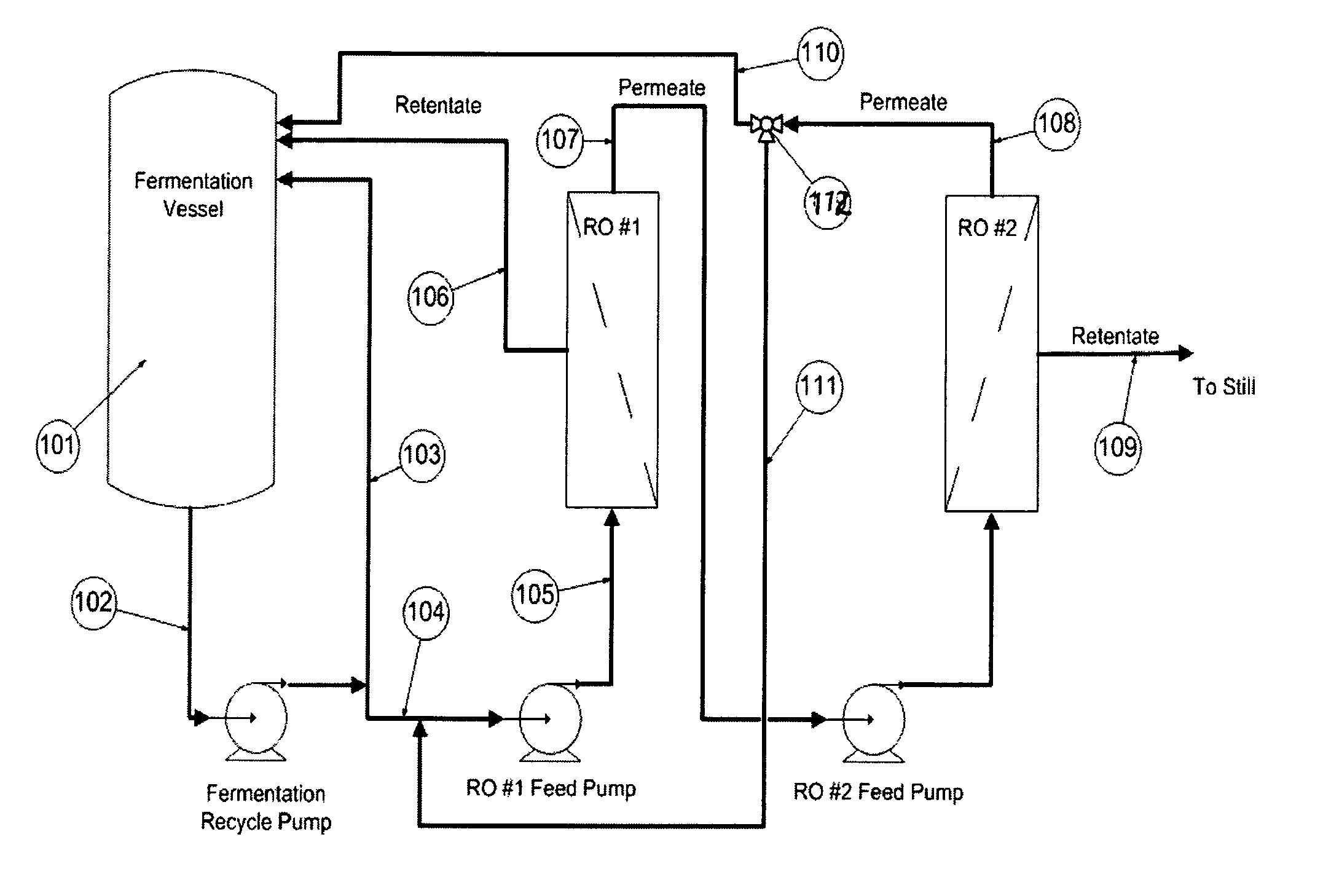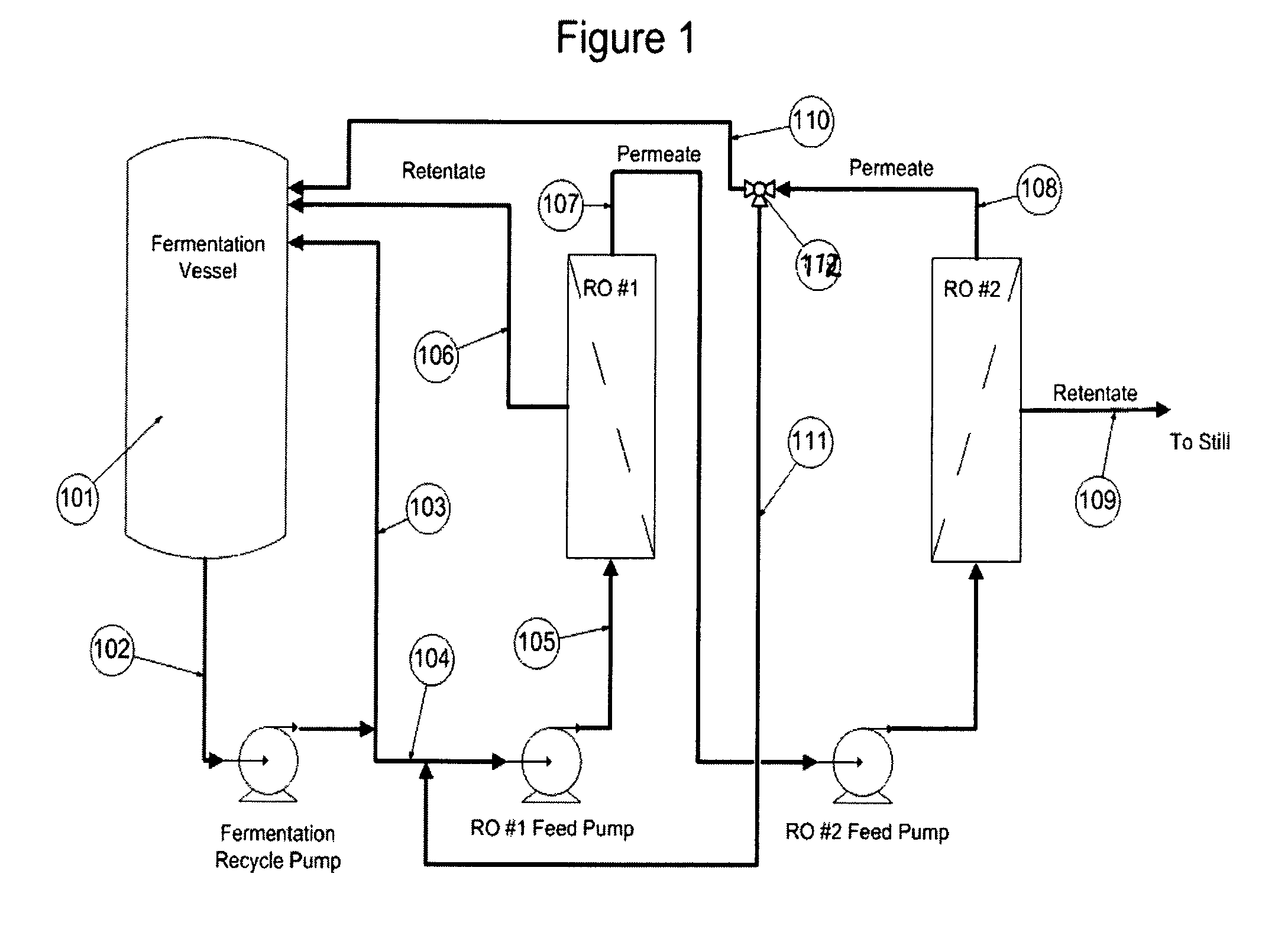Ethanol recovery from fermentation broth
- Summary
- Abstract
- Description
- Claims
- Application Information
AI Technical Summary
Benefits of technology
Problems solved by technology
Method used
Image
Examples
example 1
[0064]Fuel grade ethanol is produced from corn. A common “state of the art” method to produce fuel grade ethanol utilizes the Very High Gravity (VHG) dry milling corn process that produces a final concentration of ethanol of 110 gm / liter (14% v / v) starting with a fermentable sugar and starch solution of about 240 g / L. High ethanol concentrations are important to save energy in ethanol production. Old technology corn to ethanol fermentations produce ethanol concentrations of 50 g / L to 65 g / L and require about twice as much energy to convert the dilute ethanol to pure ethanol than would a starting ethanol concentrations of 110 g / L.
[0065]Over the course of a batch process time of 40 to 60 hours, various strains of Saccharomyces cerevisiae conditioned for high osmotic pressures of sugar and starch, with the help of additions of starch to sugar conversion enzymes, convert the resultant sugars to ethanol with an average conversion rate of 1.5 g / L / Hr to 2.5 g / L / Hr of ethanol production. Th...
example 2
[0079]This example is an improvement on Example 1 and accomplishes the high ethanol concentration product, but uses conventional fermentation yeasts. The process is run as continuous fed batch fermentation with the addition of fully converted starch sugars in quantities to exactly match the amount of ethanol produced and then removed from the fermentation reaction. This method permits lower cost conventional starch to sugar methods, the pre-filtering and recovery of higher quality ancillary corn feed and chemical products now recovered from the processes fermentation broth as still bottoms, and eliminate stuck fermentations, the fermentations that do not go to completion, in the VHG process.
[0080]Because this process is continuous, the start up conditions are only a small fraction of the total fermentation time. With this method, the fermentation can be carried on for weeks to months at a time and remains at a constant, high ethanol production rate. The process of the present invent...
example 3
[0092]As the need for non-oil based fuels increases and the production of grain crops to be turned into ethanol is limited, the use of alternate feedstock becomes highly important. Most of the alternate feedstock materials for conversion to ethanol are plant-based renewable materials, such as wood, grasses and the residues of grain crops. When converted to fermentable sugars, they contain a combination of lignin, hexose sugars from the cellulose fraction as glucose and pentose sugars from the hemicelluloses fraction as xylose. The lignin glue, which holds the cellulose and hemicelluloses fibers together, must be removed from the fermentation media and the fibers then converted to sugars. A mixture of hexose and pentose sugars results, usually high in pentose sugars, which requires less hardy yeasts and bacteria for the fermentation.
[0093]Large quantities of waste sugars, which can be converted to ethanol, are found in the wood pulping industry for paper production. Black liquors fro...
PUM
 Login to View More
Login to View More Abstract
Description
Claims
Application Information
 Login to View More
Login to View More - R&D
- Intellectual Property
- Life Sciences
- Materials
- Tech Scout
- Unparalleled Data Quality
- Higher Quality Content
- 60% Fewer Hallucinations
Browse by: Latest US Patents, China's latest patents, Technical Efficacy Thesaurus, Application Domain, Technology Topic, Popular Technical Reports.
© 2025 PatSnap. All rights reserved.Legal|Privacy policy|Modern Slavery Act Transparency Statement|Sitemap|About US| Contact US: help@patsnap.com



